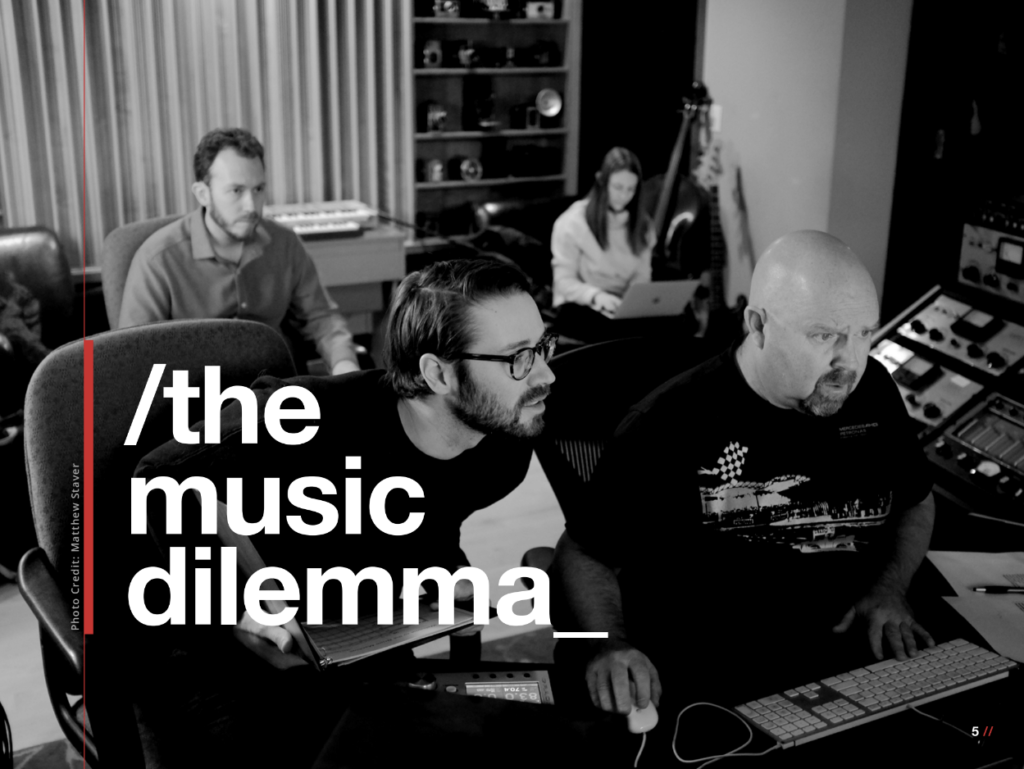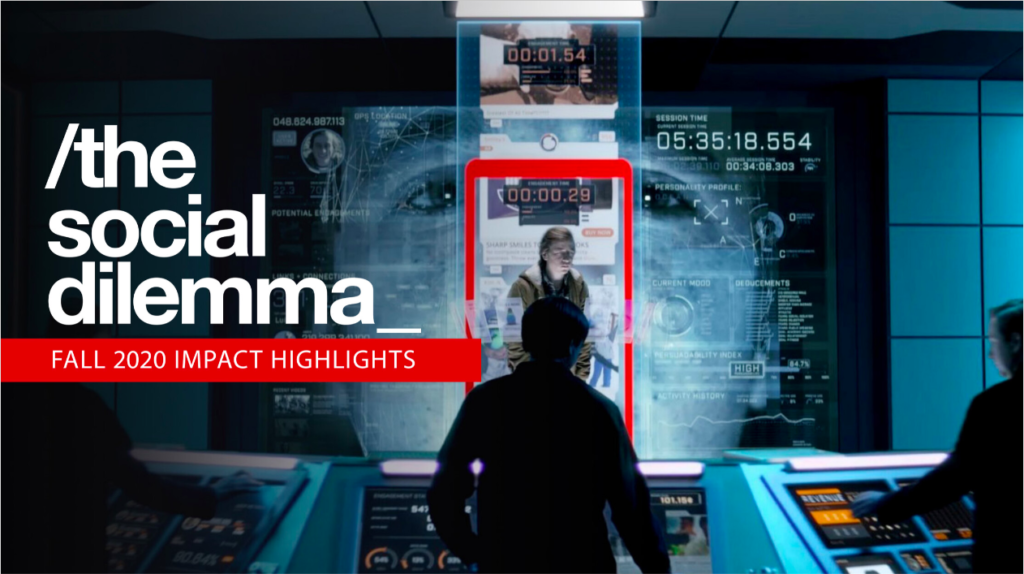The soundtrack for the Netflix original documentary ‘The Social Dilemma’ featuring the single “I Put a Spell On You” performed by 5-time Grammy award-winner Brandi Carlile and Tony and Grammy award-winning artist, Renée Elise Goldsberry is now available on all major digital music services!
Listen here: https://smarturl.it/thesocialdilemma
Q&A with composer mark crawford
The music of a film serves an integral role in setting the mood and heightening the emotional atmosphere of a scene, shaping, often times subtly, the experience of the viewer. For The Social Dilemma, composer Mark Crawford expertly scored the film to evoke an uneasiness and horror, successfully combining human-produced and mechanical sounds to enhance the film’s impactful message.
Check out our interview below to learn about Mark’s creative process and what it was like to work with Brandi Carlile and Renée Elise Goldsberry.
Can you tell us about your background and how you became interested in composing for film?
When I was in elementary school, my sister, who is eight years older than me, listened to film music while she did homework since the lack of lyrics in the music helped her concentrate. I used to listen along with her and she’d create mixtapes of film music for long car rides filled with scores by Danny Elfman, John Williams, James Newton Howard, Bernard Herrmann, and Ennio Morricone. So all throughout elementary and middle school I was the cool kid who secretly listened to classical music, John Phillips Sousa marches, ragtime, and film music while my peers were busy listening to NSYNC and Blink 182.
Also throughout elementary and middle school, my sister would invite her friends over for movie nights and I’d get to watch all the best horror films and other films that were probably way over my head. Then I’d get my hands on my family’s VHS camcorder and try to recreate them myself. I think I initially started exploring the relationship between music and film when I’d hold up a boombox playing film scores next to the camcorder to create an in-camera film score for my films. The most exciting part was showing these films to my sister’s friends and getting a reaction. I still consider that transmission of ideas and the power of art is the closest thing to magic in this world.

When you are composing a film, where do you draw your inspiration from? Can you give us a glimpse into your creative process and what a day in the life of a composer looks like?
Having a hand in all the parts and processes that make up a film has allowed me to gain empathy for every aspect of film production. I’ll try to demystify my creative process as much as I can, but a lot of it is still a mystery to me. When I initially approach a project, I try to figure out how music can blend into the full DNA of the story. What could I add to the story that isn’t already there? I identify the underlying themes, motifs, and characters and use them as a blueprint and compass for the score. I figure out the musical palette for the film the same way you’d figure out the design, colors, and visual feel before you set out to paint a picture. I begin to write and slowly take a gradual path towards what some may call “the zone”. As they say in The Beatles song “Tomorrow Never Knows”, “Turn off your mind, relax and float downstream”
It’s as if I set my dive plan before taking the plunge into a deep abyss because once I’m under, I’m in it. It’s part way between a stream of consciousness while keeping in mind the original intention of the film score. Then at some point I begin to surface and I can view the entirety of the score from a more subjective point of view. I put on my editing hat and I can shift ideas around to better mold them to the visual and story elements.
I composed the bulk of The Social Dilemma (89 minutes of music) in the span of something like 3 weeks. It was a whirlwind, but when I surfaced, a score emerged.

Diving into The Social Dilemma soundtrack, what was the concept behind the music and how does it relate to the story being told in the film?
While I was recording sound for the interview portions of the film, I began to formulate some hypotheses for how the music might come into play, and how it would interact with the unique documentary/narrative structure. For the musical direction we landed on the overarching concept of a dilemma: a fork in the road with a choice between two possibilities. With this lens, I began to see pairings, conflicts, and thematic dilemmas throughout the film: computer vs. humans, narrative world vs. documentary world, our “real world identities” vs. our digital doppelgängers.
With these ideas in mind, I experimented with both instruments and musical form, coupling acoustic instruments and their digitized counterparts, and creating connections around the interplay between human-created music structures vs. music that sounds like it was created by algorithms and machines. The experimental sketches I created became the backbone for the film’s score.
There is a lot packed into the music, but I didn’t want to call too much attention to it, and I wanted it to blend into the story’s DNA. I almost think of it as two different film scores having a dilemma throughout the film, and this underlying musical battle is something I wanted the audiences to subconsciously feel as they were following the film’s characters down the rabbit hole.
Included in the soundtrack is a cover of the song “I Put a Spell on You” performed by Brandi Carlile and Renée Elise Goldsberry. What was the inspiration behind the new verse you wrote for the cover?
I was so inspired by the audience reactions, the outrage and engagement from viewers around the world that I felt there was an opportunity to add to the conversation musically. When Davis Coombe, the editor, stuck in the Nina Simone version of “I Put a Spell on You” I thought it such a wonderful musical crystallization of the film’s concept. The message in the classic, seductive song acted as a megaphone of manipulation for the devices we use in our lives. I wanted to build on this idea using the film’s score elements, the interplay between human vs. computer instruments, to create something that moved the song into today’s social media dilemma. The musical dilemma concept also led to the idea of a duet between two vocalists in the song as well.
The beauty of the song’s original lyrics is that they’re simple and can be interpreted in many ways depending on their context. I was seeing an outpouring of frustration around the manipulation that so many people were feeling. After working on this film, and seeing other festival films like A Thousand Cuts and Coded Bias that touch on these issues, I felt like there was such a connection to this spell being cast on humanity.
I pinch myself every day that I had the opportunity to work with Renée Elise Goldsberry and Brandi Carlile, and I couldn’t have asked for a more perfect way to highlight the message in the song. Ms. Carlile’s vocal range contains so much emotional depth and adds a haunting aspect to the song. Ms. Goldsberry drops in with dynamism and power to elevate the new lyrics and adds a whole new dimension to the original version of the song. In the end, the two vocal sides intertwine. It was such an incredible collaboration with enormously talented artists who are helping shine a light on these issues.

What do you hope viewers/listeners will experience when hearing the soundtrack, whether it’s while watching the film or listening to the album on its own?
A common piece of feedback I hear from audiences regarding the score for The Social Dilemma is that they were so absorbed by the film that they didn’t notice the music, but had a constant feeling of uneasiness throughout. When I hear this I consider my mission accomplished. I set out to embed the music into the DNA of the film and guide the audience between the documentary and narrative segments. Since there’s something like 89 minutes of original music in the 93-minute film, the score acts as an undercurrent that emotionally pulls the audiences through the story with its characters.
Now that viewers can hear the soundtrack as its own standalone piece, I’m hoping listeners can take the same intimate path I made when writing the score, gradually spiraling from a more traditional orchestral film score into a pit of synthesizer madness and mechanical music and hear all the subtle uneasy and often times imperfect textures that audiences may have felt while watching the film. I wrote with a lot of thought, heart, and emotion, drawing from so much inspiration in my lifetime. The fun part is seeing how much of it will transfer onto the listener.
What are you working on next?
One of the silver linings that came out of 2020 for me was falling back in love with music all over again. While it felt like the world was falling apart, I considered music to be a life preserver, and for a bit of creative therapy, I started writing my own music free from any projects. Among these homegrown creations are around 15 demo songs for a new musical I’m mulling over, as well as a few songs inspired by the events of January 6th. After writing more of my own songs, I realize how important it is for the soul to just write for the pure love of music. Now having hibernated and incubated so many ideas, I look forward to collaborating on some upcoming projects in development and hopefully recording with many more artists once it’s safe to record.
Listen here to experience the music that gave life to
what’s hiding behind your screen.

Changemaker Spotlight: Ivy Mahsciao
Celebrating the stories of emergent voices who are shaping solutions to our social dilemma
thesocialdilemma.com